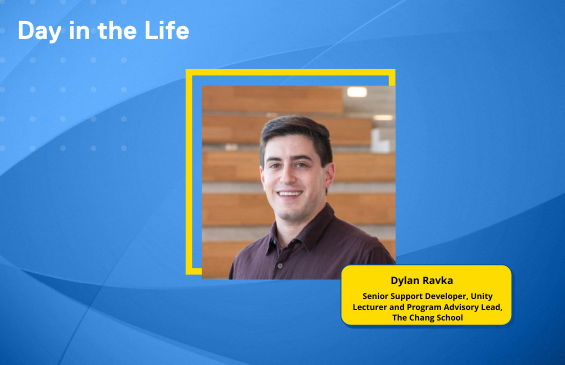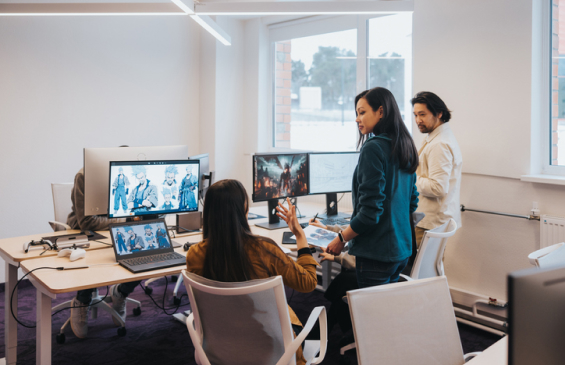What Does a Graphics Programmer Do in the Video Game Industry?

November 19, 2024
If you’ve ever marveled at the magic of visual effects, realistic lighting, and smooth animations when playing a video game, chances are a graphics programmer had a hand in bringing those elements to life.
Grace Zhu has been working as a graphics programmer for about six years and is currently at Eidos Interactive. In her role, she optimizes and debugs games for PCs and consoles like Xbox and PS4, and implements graphical features and systems involving character customization, terrain, weather and sky features, as well as visual effects (VFX). She also works with artists to help develop characters, environments, and VFX shaders.
Formal Education vs. Self-Taught
Like many in her field, Grace has a Bachelor’s Degree in Computer Science, which gave her a foundation for programming. But also like many of her contemporaries, the specific knowledge she needed for her area in the gaming industry, graphics programming, came from her picking it up on her own over the years. With more and more post-secondary institutions offering academic programs for the gaming industry – like The Chang School’s Certificate in Programming for Game Development – it’s even easier to get a specialized skill set and experience to complement a foundational degree like computer science.
“My degree had one graphics programming course and one game development course, where I picked up the basics of OpenGL 1.0 – a really old way of doing computer graphics – and Unity,” says Grace. “From there, I learned more of Unity when I landed my first job in the industry, although everything else related to modern graphics programming like shaders, optimization, and graphical APIs like DirectX or Vulkan, I learned on my own.”
Unity is a real-time development platform where users can create and grow 3D games, apps, and experiences for entertainment, film, automotive, architecture, and many other industries. Chang School Stories recently spoke with Dylan Ravka, Senior Support Developer at Unity, about what a typical day looks like for him at the organization.
Persistence is Key
Beyond the skills required for the job, Dr. Cayley Bower, Research and Data Analyst, The Chang School, points out in a previous interview, that persistence is key to getting a foot in the door in this highly competitive industry. Grace adds that it’s especially important to have this characteristic trait in today’s economic climate.
“In many ways, it’s harder than ever to get into the industry,” she says. “Having a ‘plan B’ or alternatives to keep up with life is key while continuing to develop your skills or portfolio.”
Looking back, Grace says she didn’t get a job in the field immediately and had to pursue her passion for gaming as a side hustle to her 9 to 5 job as an iOS app developer. During that time, she continued to apply for entry-level positions at gaming companies, relying on her portfolio of game jams and volunteer projects that she did during her undergraduate degree to demonstrate that she had the skills employers were looking for.
While having a strong portfolio is recommended, Grace also credits her break into the industry with waiting for the right opportunity and networking with people working in gaming. “All of my jobs in the gaming industry have come from some kind of referral from someone I knew at the company,” she says.
What a Typical Day Looks Like
Like most jobs across various industries, Grace’s start to the day involves seeing what needs to be done and what meetings she has (and, of course, coffee). She then checks her messages to see whether code reviews have come in and if she needs to sync to the latest version of the game build (she often does this while she plans her tasks for the day).
Grace explains what this means in more detail: “Syncing to the latest version involves updating my local copy of the game in progress to the version that’s on the servers, which contain the latest changes from everyone else working on the game.”
In terms of meetings, she usually has one or two meetings every day to sync with the team and weekly meetings to sync with other programmers on her team as well as artists and designers related to the feature she’s working on.
“Most meetings are structured like stand-ups where everyone gives an update on what they’re working on and how it’s going,” she says. “Less regular meetings but those that are still recurring include people from different disciplines who need to work on the same feature so they can ask questions and make sure everyone understands what the end result is.”
She adds that an example of this would be a meeting focused on the topic of a main playable character might involve gameplay programmers, artists (3D, VFX, and animation), game and sound designers, among others.
Another large part of her role is testing, which consists of running the game and making sure what she’s doing looks like what she expects in the game. “I might inspect various debug views of the game under different lighting scenarios or gameplay conditions,” Grace explains. “To dive even deeper, I can capture a specific frame of the running game and have even more data about what is being displayed on screen.”
At the end of the day, Grace leaves a few notes for herself so she can quickly pick everything back up the next day.
With the nature of Grace’s job being all online, she’s able to work from home most of the time except when she has to commute into work. However, she says she looks forward to socializing with her co-workers throughout the day when she’s in the office during coffee breaks and happy hour at the end of the day on some days of the week.
Best Part About the Job
As with most workplaces, there are ups and downs. In Grace’s case, as with any type of technology, things can break unexpectedly, especially when there are updates or tools that break the game. That part isn’t Grace’s favourite but she overcomes it and it’s all part of the game (quite literally).
Overall, she is grateful her persistence paid off, allowing her to break into this highly competitive and sought-after industry. The best part of the job for Grace is working with the rest of the team to bring the game to life.
“One of the best parts of my job is working with people who are just as passionate about making games as I am.”


